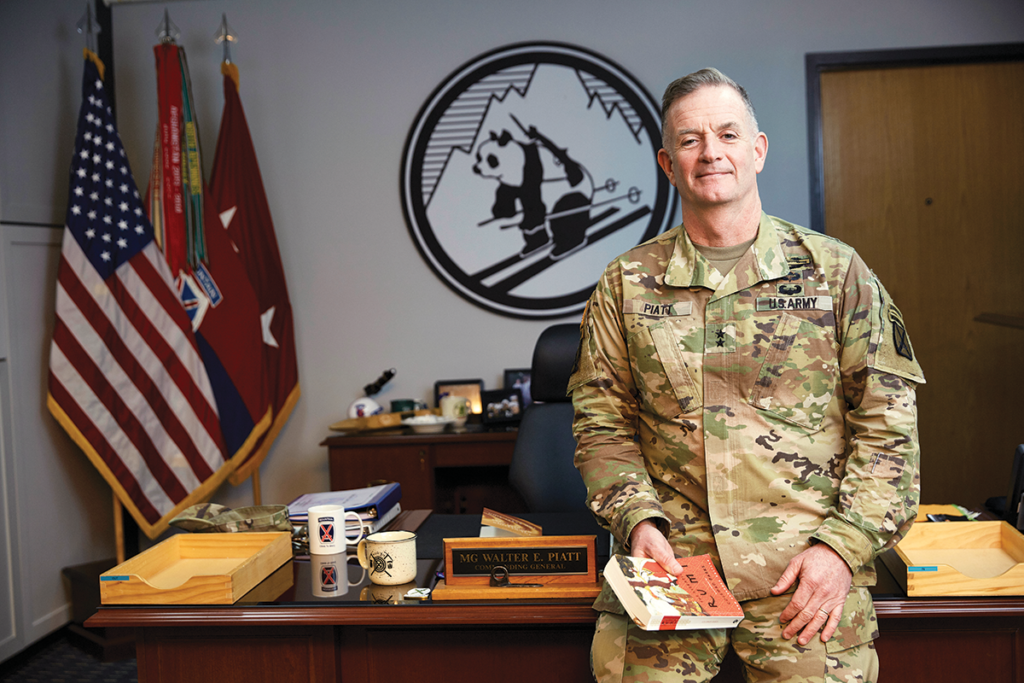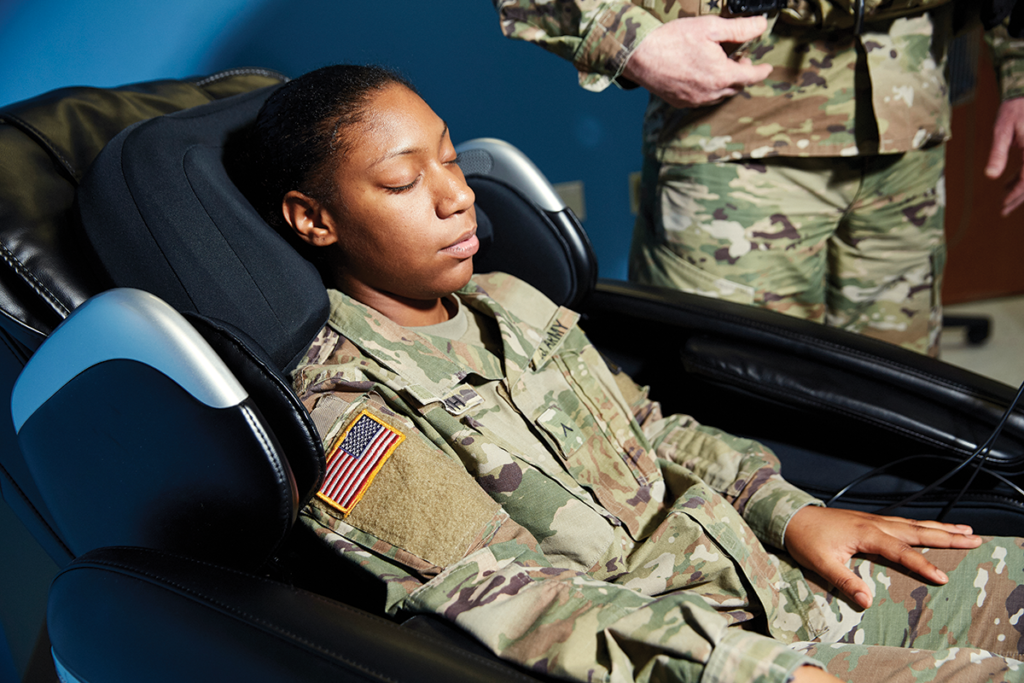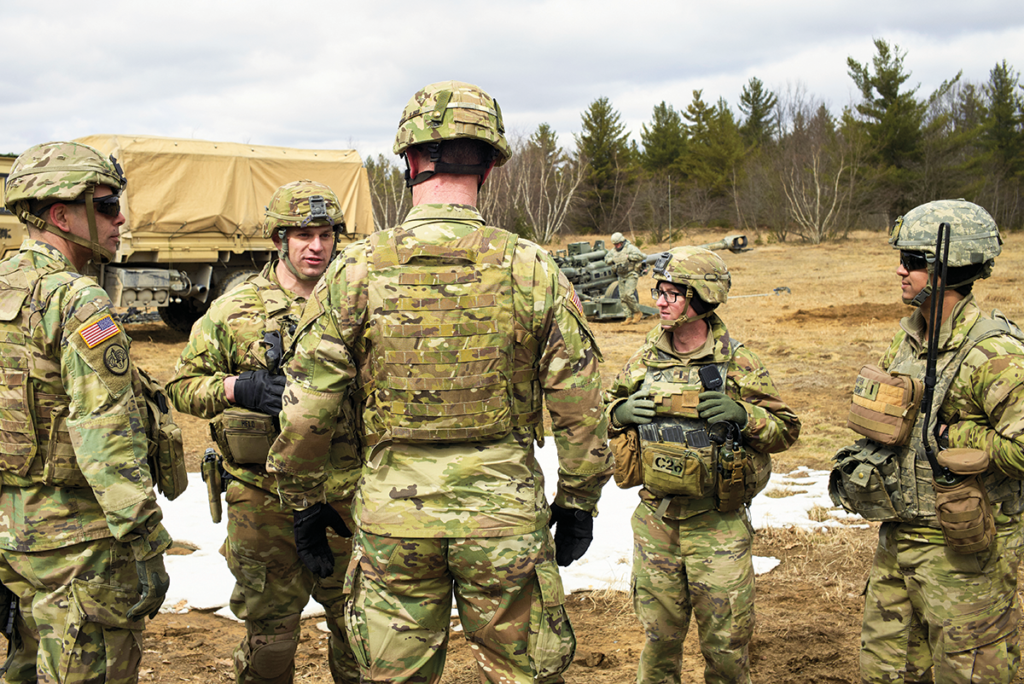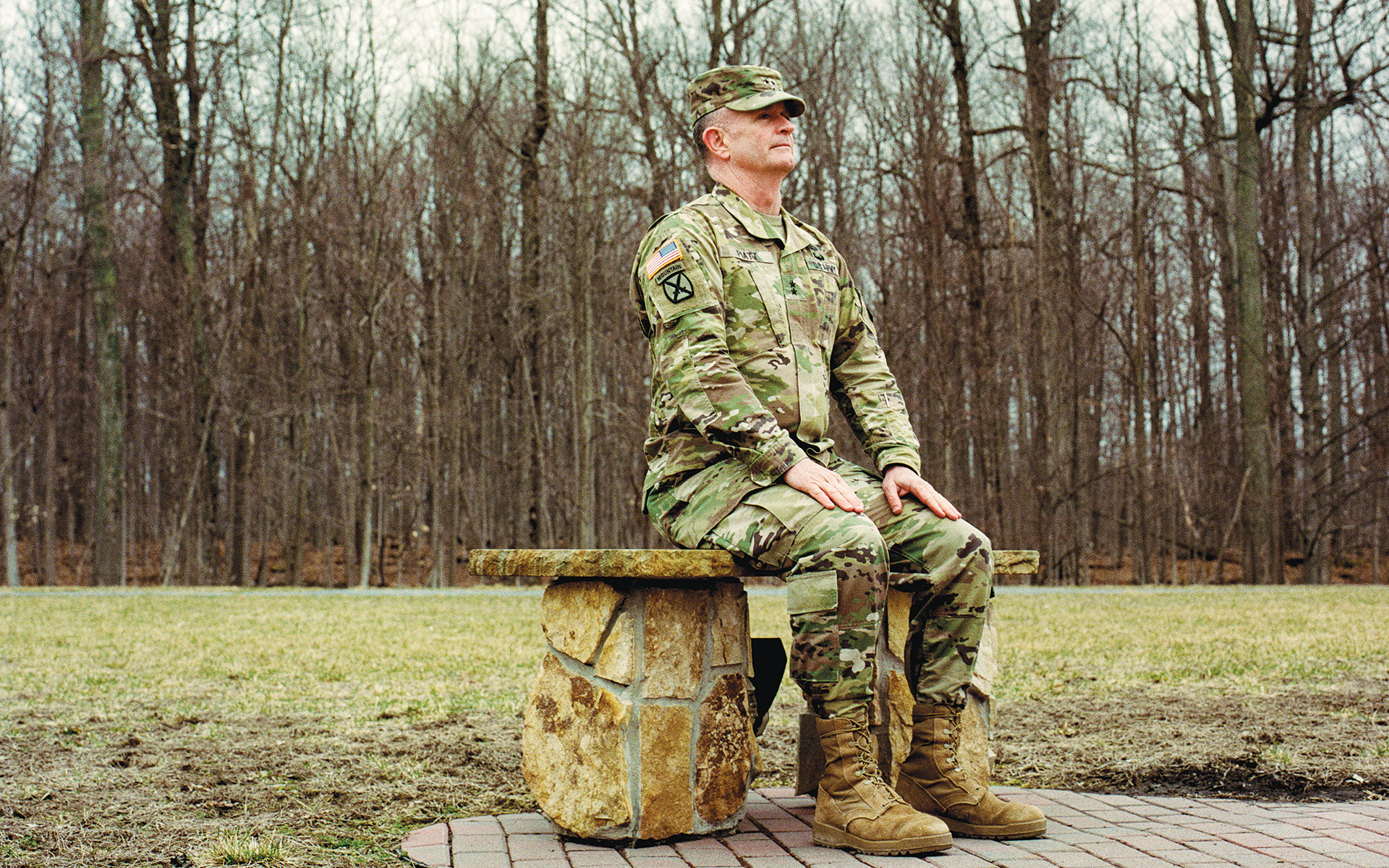The bell rings, and the 21 cadets in Major Matt Jarman’s leadership class at Virginia Military Institute stand at attention as their highest-ranking classmate salutes the professor. Though the weather outside is mild, the cadets are dressed in their winter uniforms. Black neckties are tied in Windsor knots and tucked between the second and third buttons of their black long-sleeved shirts. Woolen garrison hats sit on the classroom tables next to open laptops.
“Today we’re going to do a little introduction to meditation,” says Jarman, an assistant professor of psychology. This is not what future military officers usually hear, so he cautiously probes their receptiveness. “When you hear mindfulness meditation, what do you think?”
The cadets call out free-association words: purposeful, tranquility, recalibrating. One attempts a longer definition. “It’s almost like slow motion,” he says. “You know the next move you’ve got to make. You have to do it quickly. But in your mind, you slow everything around you, so that you can make that decision as efficiently as possible.”
“How often are you guys distracted or daydreaming?” Jarman asks. “How often are you stressed?” All the time, the class responds in various forms. Days are regimented at VMI, a state-supported college that feeds into all five US armed forces. Rules govern everything from how cadets arrange their toiletries to what they wear to sleep.
Jarman explains that an emerging body of research suggests that mindfulness practices might help troops cope with the rigors of military life, particularly as they prepare for combat. Studies with Army soldiers and Marines have found that mindfulness strengthens concentration, short-term memory, and emotional regulation—essential skills under fire.
“Pre-deployment training is intentionally stressful and demanding, right?” Jarman tells his students. “If you look at cognitive function of those service members at the end of that, it’s depleted, understandably.” Compromised thinking causes troubles on the battlefield. “If you’re making a life-or-death decision, you want to be able to hold more things in mind—to consider more options, more avenues—before making a decision. When you’re depleted, it’s literally more difficult to do that.”
“If you’re making a life-or-death decision, you want to be able to hold more things in mind—to consider more options, more avenues—before making a decision.”
There are practices that can help maintain mental capacity under stress, he says. One of them is mindfulness meditation.
When Jarman began teaching at VMI in 2015, he worried that cadets would dismiss meditation as a practice unbefitting a warrior. He needn’t have worried. His students see their own role models meditating. “I heard LeBron James does it during games,” one young man says of the basketball star. “It makes me think that I should probably start doing it.”
Jarman explains that meditation is not meant to be fun. Focusing on one’s breathing, observing when the mind wanders, and returning attention back to breath requires discipline. It’s like weight-training, he says: “Every time you notice you’re distracted and bring your mind back, you can think of that as a repetition at the gym.”
Then it’s time to practice. The cadets sit upright, tuck in their chins, and shift their gazes downward. The room falls silent for five minutes. Afterward, Jarman asks for reactions.
“My mind was really good at sneaking getting distracted,” says a cadet. “Not just random thoughts, but thinking about the meditation.”
“Our minds are very clever,” Jarman says. As we try to quiet them, they manufacture what seem like critical insights. “That’s the beauty of the system: You treat any thought, no matter the content, the same way. You notice it, let it pass, return to breath.”
Many of these cadets will join the armed forces: VMI says 50 to 60 percent of its graduates take military commissions, and almost one-fifth make it their careers. They will enter the Army, Navy, Air Force, Marine Corps, and Coast Guard at a time when researchers are recommending that mindfulness become as integral a part of training as physical fitness. As evidence mounts that practices like meditation could cultivate a better-skilled fighting force, the military is still deciding whether to heed the advice.

The United States has been sending troops into conflict zones for most of the past two decades, and the stresses faced by fighting forces can be crushing. Army Lieutenant General Walt Piatt discovered in the years following the September 11 attacks how those stresses bleed over into life back home.
At the time, Piatt was a brigade commander with the 25th Infantry Division at Schofield Barracks in Hawaii. He had deployed to Iraq every other year and watched some of his soldiers melt down whenever they returned Stateside. They drank too much, beat their spouses, and drove their motorcycles dangerously fast.
“It’s like getting off a freeway and getting into an elevator,” he says of those homecomings. “Everything slows down, but our mind was still in that combat zone, operating at that level of alertness that was no longer required.”
The Army’s reintegration training, designed to ease soldiers back into family life, couldn’t keep pace with that depressurization. “We were desperate,” says Piatt, who now serves as director of the Army Staff. “What we had been doing had not been working.”
Through a colleague, Piatt met one of the country’s top scientists in the mindfulness arena: Amishi Jha, an associate professor of psychology at the University of Miami. Jha and Elizabeth Stanley, an associate professor of security studies at Georgetown University, had earlier conducted a pilot study with Marine reservists preparing to deploy to Iraq. That study, first published in 2010, tested how mindfulness training affected “working memory capacity,” the ability to retain and use relevant information over short periods of time without being distracted.
“I describe working memory as the mind’s whiteboard, with disappearing ink,” says Jha, a cognitive neuroscientist. “What we put up there, and write over and over again, moment by moment, makes up our current conscious experience. If your whiteboard is filled with preoccupations, worries, random distracting thoughts, and whatever your technology is throwing at you, there’s not going to be a lot of room left for you to have access to the information you need to make important decisions.” It will also be harder, she says, to regulate your emotions.
Researching the Impact of Mindfulness
Before shipping overseas, troops undergotraining that includes “stress inoculation,” designed to prepare them for the intensity of combat. High stress, however, often depletes working memory. The researchers →hoped that mindfulness training might help the Marines survive the pre-deployment period with their cognitive skills intact.
The results of the pilot study, Stanley says, exceeded her expectations. Among Marines who practiced mindfulness at least 12 minutes a day, “they didn’t just preserve working memory capacity,” she says. “They actually improved.” The more they practiced, the more they benefited.
After the pilot study, Jha and Stanley wanted to expand their research. “We had a series of grants in the can,” Jha says, “but couldn’t find anyone who would take on our project, because we were asking for quite a bit of time.”
They found a champion in Piatt. The general helped them launch a study at Schofield Barracks in 2010 that demonstrated that certain types of mindfulness training helped servicemembers concentrate better and tune out distractions, even as they prepared for deployment. Piatt also advised Jha and her colleague Scott Rogers as they developed a program called Mindfulness-Based Attention Training (MBAT), crafted for military populations and designed to be taught by non-experts.
Working with Piatt, says Jha, has given her “the support of a leader who is interested in mindfulness and has actually started practicing himself.” She also gained an ally who understands military culture, and how to use language to win support. Piatt talks about mindfulness as “zeroing the mind,” just as a soldier zeroes a weapon by aligning the sight with the target. “The soldiers will understand it,” Piatt says. “It translates better and then you reduce that wall of skepticism.”
Jha continues to expand her research. She’s talking with militaries in other countries. She’s collaborating with VMI’s Jarman on a project looking at mindfulness and leadership skills. She has worked, too, with military spouses. This year she published an article chronicling her work with 120 members of a US special-operations forces unit. (She can’t say which branch.) That study, published in the journal Progress in Brain Research, showed that the elite troops gained working memory, and were better able to pay attention, when they took a month-long mindfulness class and practiced the skills daily.
Much of Jha’s research today focuses not on proving the value of mindfulness training, but rather on figuring out how to best implement it in a time-constrained military. “What’s a good amount of time that would allow units to take it on, and not so burdensome that they say, ‘Forget it, we can’t do it’?” she asks.
Jha’s interaction with the special-operations forces highlights the quandary: “They said, ‘Can you give them this mindfulness training in one day?’ They didn’t really understand: Would you ever train for a marathon in a day?”
“They said, ‘Can you give them this mindfulness training in one day?’ They didn’t really understand: Would you ever train for a marathon in a day?”
For some of the elite forces, Jha did try to compress the eight-hour training into two weeks. She found it considerably less effective than a four-week program. (Earlier trainings were spread over eight weeks.)
This type of inquiry makes Stanley uneasy, and she has parted company with Jha over it. “Some military leaders were interested in seeing how low can you go,” she says. That approach, she worries, could backfire if service members don’t receive a full suite of coping tools. “Mindfulness alone, without the skills to re-regulate the mind-body system, may flood someone with heightened attention on their stress, which may amplify their stress arousal and its cognitive, emotional, and physiological effects,” she says. Stanley believes the training must be gradual, taught by experienced instructors, and combined with other skills to help soldiers “rewire” how they process difficult experiences. She favors a 20-hour curriculum.
Jha says that she and other researchers are looking for solutions that are safe and effective, and also realistic within the military’s culture. “We need to balance the time burden of taking minutes away from their training calendar with not going so low that it’s not effective,” she says. “If it’s a non-starter to offer a 20-hour program, even if in the end it may have some more subtle benefits, I just can’t go into that direction. I still have to meet people where they’re at.”
Mindfulness researchers elsewhere have had promising results working with submariners in France and soldiers in the Israel Defense Force. Last April, participants at a NATO-sponsored wellness conference in Berlin heard from Anders Meland, a Norwegian psychologist who studied a helicopter unit in his country. Meland found that mindfulness practices reduced stress by creating a “restful, alert, and flexible state of mind.”
At City University of London, psychologist Jutta Tobias Mortlock has been working with the United Kingdom Ministry of Defence, which she says is trying to build a culture with “less command and control.” In particular, she’s looking at “collective mindfulness”: a team’s ability to anticipate and deal with conflict by remaining engaged with one another rather than retreating into individual corners.
The US military is conducting its own studies. Thomas Nassif, a research psychologist at the Walter Reed Army Institute of Research, analyzed survey data from 1,100 soldiers returning from Afghanistan. “You talk about a pretty banged-up population,” he says: Most had dodged small-arms fire, witnessed dead bodies, and known others who were killed or seriously injured. Nassif found that the most mindful participants—those who noticed, and then let go of, their distressing thoughts—were less likely to suffer from pain, depression, and post-traumatic stress disorder (PTSD). They also engaged in fewer risky behaviors like driving recklessly, carrying weapons needlessly, and looking for fights. →
Nassif has just conducted a study at Hawaii’s Schofield Barracks to see whether mindfulness training can improve performance in skills like marksmanship, along with health outcomes like sleep quality. He’s currently analyzing the data.
More developed is the body of research that shows meditation, yoga, and related practices to be valuable for veterans with PTSD. Anthony King, an assistant professor of psychiatry at the University of Michigan, says that mindfulness-based therapies can help those who avoid situations like crowded supermarkets, which might trigger their symptoms.
Avoidance, many experts believe, helps perpetuate PTSD symptoms. “People don’t get normal environmental extinction of these fear memories because they never go out, because they protect themselves from coming into contact with things that remind them of their trauma,” King says. Exposure therapy, in which veterans intentionally visit safe places that trigger anxiety, is by definition unpleasant. But mindfulness, he says, can serve as a gentler form of exposure therapy.
“Rather than putting yourself in a crowded situation that might cause panic,” King says, “you’re actually just exposing yourself to the extemporaneous contents of your mind—what’s happening that moment. And rather than reacting in horror, or trying to distract, or turn on the TV, or turn on the radio, or exercise, or whatever, in the mindfulness meditation you’re invited to just sit with that: to watch that thought arise, watch it develop, watch it pass.”

With mounting evidence that mindfulness practices can produce warriors who are more attentive, less distracted, and more emotionally resilient, some researchers argue that such training should become routine for all troops.
“The level of seriousness taken for physical training shows up in how much time is given daily for it,” says Jha. “What I’d like to see is that that same level of seriousness is offered to mental training.”
The armed forces are not quick adopters. Research by Jha and other scientists “is slowly gathering the attention of the military in very serious ways,” says General Piatt. But there is currently no systemwide initiative to incorporate mindfulness into troop training. “Sadly, I haven’t been as successful as I would like to have been,” he says.
Some of the reason is cultural, says Valerie Rice, a mindfulness researcher at the US Army Research Laboratory at Fort Sam Houston in San Antonio, Texas. “I had a commander tell me, flat out, ‘I don’t want my soldiers to go to a mindfulness class because after the class they’ll be relaxed and lazy,’” she says. That’s why studies matter, she adds: They help convince military leaders there’s data to support this new type of training. “It takes time and it takes information, and it takes recognition and belief in the results,” she says.
Nancy Skopp, a research psychologist at the US Department of Defense’s Psychological Health Center of Excellence in Falls Church, Virginia, points to the military’s research investment—its grants to Jha, for example—as evidence of its serious interest. “DoD will fund a project that looks promising, and based on those results, then that can influence policy,” she says. Skopp singles out Jha’s efforts to train non-experts as trainers: “If mindfulness nonclinicians can deliver this, then it can be disseminated more rapidly.”
Jha isn’t discouraged by the slow pace of adoption. “I am glad that they’re wanting the science to be strong enough before they roll it out,” she says. “Whatever they decide to roll out will be interrogated, scrutinized for evidence base. And now we’ve established the evidence base.”
Working with Stress Warriors
by Stephanie Domet
Amishi Jha knew she needed help when her toddler looked up at her during story time and asked what a Womp was. Jha had read this same book to her son dozens of times, and had been truly looking forward to spending this time with him. “What is he talking about?” she remembers thinking, realizing she didn’t have a clue—though she’d been reading about Womps for several pages, and had over successive nights.
She was in her second year as an assistant professor, her husband was starting grad school, and she’d lost the feeling in her teeth from grinding them so ferociously. “I was at the point of quitting. I needed to do something that felt more manageable to me.”
That something turned out to be meditation, and it became more than just a personal daily practice for her. A neuroscientist, Jha began to study the effects of mindfulness on people in high-stress cohorts, like medical students and nurses.
A tragic story turned her attention in another direction. The perpetrator of a school shooting near Philadelphia, where she then lived, was identified in early news reports as a military veteran. And though it turned out the shooter had no connection to the military, for Jha, there was a moment of sharp recognition.
“At that point we were already eight years into this Afghanistan conflict, and I felt we were seeding our society with psychosis but there was nothing being done to protect against that. So my openness to working with military personnel came from: What can I possibly do?”
As much as Jha may have met with some resistance from soldiers, she began this work a decade ago with resistance of her own. She didn’t know anyone in the military then, and she was raised Hindu, with a strong adherence to nonviolence. “Working with warriors is a really new experience for me, but what I’ve come to understand about many of the people I’ve met is peace is more important to them, because they’re the front line of having to actually play a role in achieving it.”
For Jha, that makes the work she’s doing all the more vital, though it brings with it challenges her peers don’t necessarily face in their labs, where tightly controlled studies are carried out with the participation of volunteer subjects. “I don’t have that. I have to work with the timeline military leaders offer me. I get the visits that I get. But we are helping real people in their real lives be better able to face the challenges that we as a nation are asking them to endure.”
And Jha hears from those real people about the impact mindfulness has had on their lives, like the helicopter pilot who got in touch to say, “Literally, mindfulness saved my life. I heard your podcast, and I asked my brigade surgeon to teach me about mindfulness and I gained an understanding of my mind that helped me not only in my job, but in my marriage.” Jha says, “Obviously that’s not me, that’s the practice, but it does make me feel like the effort that has gone into it—and it is a difficult journey to bring these practices into communities that don’t always feel that they need them—when you hear that it gives people something of their own capacity back, that’s really exciting.”
That helicopter pilot isn’t an outlier. Jha says she regularly hears from military personnel who have had mindfulness training that they are able to be in the joyful, human moments of their lives with attention—as well as have tools at their disposal to reach for in the life-and-death moments they may face in the field. “You want to be there for the joys in your life, but the distractibility, the demand, and the rumination can just suck you away from those moments, and you don’t know how to get back, and what I feel we get the privilege to hear from people is: I am able to be attentive and present for these precious moments of my life as well. It’s not just the job, it’s the whole person benefiting from this.”
Jha says those benefits apply equally to leaders as they do to soldiers. “It has a positive contagion for the entire organization when the leader is informed and able to practice mindfulness,” she says. She was invited to give a keynote address at a symposium called Evidence-based Leader Interventions for Health and Wellness as part of a NATO conference in Berlin, Germany, in April. And some military leaders are already on board. Jha remembers a conversation she had with a former US Surgeon General. “When he left the Army, they did an exit interview with him and asked what is one thing we could have offered you that would have helped you be an even better leader, and he said, ‘I wish I had learned mindfulness earlier in my career.’ That meant a lot to me,” Jha says. “He sees it.”
Should Mindfulness Be Taught to The Military?
by Barry Yeoman
Mindfulness, a basic human capability that can be cultivated through meditation, has historically been associated with various forms of Buddhist practice. Some within that community have questioned whether it’s appropriate to use meditation in secular institutions with different values. That’s at the heart of an ongoing debate over the use of such training in the military.
To neuroscientist Amishi Jha, the answer lies in the evidence. In lab experiments measuring attention, service members trained in mindfulness make fewer testing errors. “They’re less likely to press the button when they shouldn’t,” she says. “When people turn that task into a shoot/no-shoot version, we can hope they’ll be less likely to pull the trigger when they shouldn’t.”
Still, some practitioners in the Buddhist tradition have challenged the premise of Jha’s research. In 2014, the now-defunct journal Inquiring Minds published a commentary by dharma instructor Ronald Purser, who lamented the reframing of mindfulness as a “decontextualized, ethically neutral, attention- enhancement technique” rather than a spiritual practice.
Fundamental to Buddhist mindfulness, Purser wrote, is “a cardinal prohibition against intentionally killing a living being.” That, argued the San Francisco State University management professor, makes it incompatible with military training. In the armed forces, “new recruits are systematically trained to kill, maim, and inflict harm when ordered through desensitization, operational conditioning, and denial defense mechanisms.”
The journal also published a counterpoint by Georgetown University’s Elizabeth Stanley, who has done intensive mindfulness practice in Myanmar, and whose family has served in the US Army since the Revolutionary War.
“If the nation’s leaders have decided to send troops into harm’s way, those troops’ hearts, minds, and bodies will experience the stressors of war—whether they are mindfully paying attention or not,” wrote the former Army intelligence officer. “With mindfulness, however, they are more likely to see the environment around them clearly, without being influenced by unconscious ‘survival brain’ filters that can exaggerate what’s really there. They are more likely to regulate their hard-wired stress response and the reactive impulses this stress response can create.”
As a result, Stanley wrote, “they are more likely to pull the trigger only when they really need to—when imminent harm to themselves or those they are protecting actually exists.”

Try This Focused Meditation Practice
How can mindfulness practices be adapted for military culture? The University of Miami’s Amishi Jha and Scott Rogers, developers of Mindfulness-Based Attention and Training (MBAT), created this sample practice.
This 12-minute drill aims to bring the mind “At Attention” from a seated position, in the same way one can be called to the standing position of attention.
- Sit in an upright and stable position.
- Keep your head erect and facing straight to the front as you breathe.
- Keep your arms hanging straight without stiffness, allowing your hands to rest flat on top of your thighs.
- Slowly and with intention, bring your heels together, toes pointed out at a 45-degree angle.
- Relax your heels, noticing their contact with the ground.
- Next, bring the mind to attention.
- Bring awareness to your posture and to the contact points your body makes with the chair and floor.
- Rest your attention on your breath, noticing the natural flow of the in-breath and the out-breath.
- Direct your attention to sensations in the abdomen, or where air enters your nose or mouth.
- When you notice that your mind has wandered, which it will, for it is in the nature of the mind to wander, redeploy your attention to the breath.
- Continue this practice of attending to the breath, deliberately escorting your attention back to the breath when you notice that your mind has wandered.
- Hold the mind At Attention in this manner for the remainder of this drill, steady, and noticing.
- As we conclude this
- At Attention Drill, return to the At Ease position. Resume your duty day activities.



